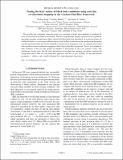Testing the Kerr nature of black hole candidates using iron line reverberation mapping in the Cardoso-Pani-Rico framework
Author(s)
Jiang, Jiachen; Bambi, Cosimo; Steiner, James F
DownloadPhysRevD.93.123008.pdf (2.976Mb)
PUBLISHER_POLICY
Publisher Policy
Article is made available in accordance with the publisher's policy and may be subject to US copyright law. Please refer to the publisher's site for terms of use.
Terms of use
Metadata
Show full item recordAbstract
The iron Kα line commonly observed in the x-ray spectrum of black hole candidates is produced by x-ray fluorescence of the inner accretion disk. This line can potentially be quite a powerful tool to probe the spacetime geometry around these objects and test the Kerr black hole hypothesis. In a previous paper, we studied the ability to constrain possible deviations from the Kerr solution from the standard time-integrated iron line spectrum within the Cardoso-Pani-Rico framework. In the present work, we expand on that study and consider iron line reverberation mapping in the Cardoso-Pani-Rico framework. That is, we consider the time evolution of the iron line profile in response to fluctuations in the x-ray primary source. Our simulations clearly show that the time informatio n in reverberation mapping can better constrain the background metric than the time-integrated approach, and this is true, notably, for the deformation parameter ϵ[subscript 3][superscript r], which is only weakly informed by a time-integrated observation.
Date issued
2016-06Department
MIT Kavli Institute for Astrophysics and Space ResearchJournal
Physical Review D
Publisher
American Physical Society
Citation
Jiang, Jiachen et al. “Testing the Kerr Nature of Black Hole Candidates Using Iron Line Reverberation Mapping in the Cardoso-Pani-Rico Framework.” Physical Review D 93, 12 (June 2016): 123008 © 2016 American Physical Society
Version: Final published version
ISSN
2470-0010
2470-0029